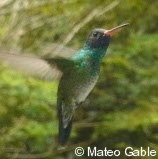 El "Chivito de los páramos" (Oxypogon guerinii) es un colibrí fascinante, ya que el aspecto de los machos es sumamente vistoso. Fué registrado por Boissonneau en 1840. Esta eve es oriunda de Colombia y Venezuela, sin embargo ha sido vista en Brasil en una región muy próxima a la frontera con Colombia. En portugués es llamada "Beija flor barbudo de elmo" (Besa flor barbudo con casco). De pico a cola mide 12 cm.
El "Chivito de los páramos" (Oxypogon guerinii) es un colibrí fascinante, ya que el aspecto de los machos es sumamente vistoso. Fué registrado por Boissonneau en 1840. Esta eve es oriunda de Colombia y Venezuela, sin embargo ha sido vista en Brasil en una región muy próxima a la frontera con Colombia. En portugués es llamada "Beija flor barbudo de elmo" (Besa flor barbudo con casco). De pico a cola mide 12 cm.The "Bearded helmetcrest" (Oxypogon guerinii) is a fascinating hummingbird, because the appearence of the males is very showy. It was registered by Boissonneau in 1840. This bird is located in Colombia and Venezuela, however has been seen in Brazil in a near region to the border with Colombia. In Portuguese it is called "Beija flor barbudo de elmo" (Flower-kisser bearded helmet). From peak to tail it measures 4.72 in.










